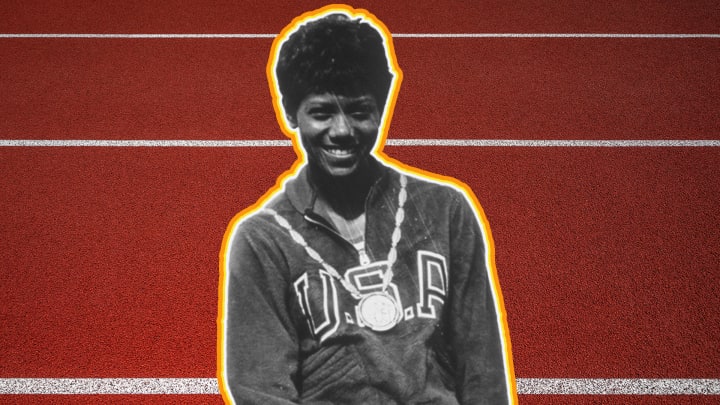10 Fast Facts About Wilma Rudolph

Wilma Rudolph made history as a Black woman athlete at the 1960 Summer Olympics in Rome, Italy. The 20-year-old Tennessee State University sprinter was the first American woman to win three gold medals at one Olympics. Rudolph’s heroics in the 100-meter, 200-meter, and 4 x 100-meter events only lasted seconds, but her legend persists decades later, despite her untimely 1994 death from cancer at age 54. Here are some facts about this U.S. Olympic Hall of Fame member.
1. Wilma Rudolph faced poverty and polio as a child.
When Rudolph was born prematurely on June 23, 1940, in Clarksville, Tennessee, she weighed just 4.5 pounds. Olympic dreams seemed impossible for Rudolph, whose impoverished family included 21 other siblings. Among other maladies, she had measles, mumps, and pneumonia by age 4. Most devastatingly, polio twisted her left leg, and she wore leg braces until she was 9.
2. Wilma Rudolph originally wanted to play basketball.
At Clarksville’s Burt High School, Rudolph flourished on the basketball court. Nearly 6 feet tall, she studied the game, and ran track to keep in shape. However, while competing in the state basketball championship in Nashville, the 14-year-old speedster met a referee named Ed Temple, who doubled as the acclaimed coach of the Tennessee State Tigerbelles track team. Temple, who would coach at the 1960 and 1964 Olympics, recruited Rudolph.
3. Wilma Rudolph made her Olympic debut as a teenager.
Rudolph hit the limelight at 16, earning a bronze medal in the 4 x 100-meter relay at the 1956 Summer Olympics in Melbourne, Australia. But that didn’t compare to the media hype when she won three gold medals in 1960. French journalists called her “The Black Pearl,” the Italian press hailed “The Black Gazelle,” and in America, Rudolph was “The Tornado.”
4. After her gold medals, Wilma Rudolph insisted on a racially integrated homecoming.
Tennessee governor Buford Ellington, who supported racial segregation, intended to oversee the Clarksville celebrations when Rudolph returned from Rome. However, she refused to attend her parade or victory banquet unless both were open to Black and white people. Rudolph got her wish, resulting in the first integrated events in the city’s history.
5. Muhammad Ali had a crush on Wilma Rudolph.
Ali—known as Cassius Clay when he won the 1960 Olympic light heavyweight boxing title—befriended Rudolph in Rome. That fall, the 18-year-old boxer invited Rudolph to his native Louisville, Kentucky. He drove her around in a pink Cadillac convertible.
6. John F. Kennedy literally fell over when he invited Wilma Rudolph to the White House.
In 1961, Rudolph met JFK in the Oval Office. After getting some photos taken together, the president attempted to sit down in his rocking chair and tumbled to the floor. Kennedy quipped: “It’s not every day that I get to meet an Olympic champion.” They chatted for about 30 minutes.
7. Wilma Rudolph held three world records when she retired.
Rudolph chose to go out on top and retired in 1962 at just 22 years old. Her 100-meter (11.2 seconds), 200-meter (22.9 seconds), and 4 x 100-meter relay (44.3 seconds) world records all lasted several years.
8. Wilma Rudolph visited West African countries as a goodwill ambassador.
The U.S. State Department sent Rudolph to the 1963 Friendship Games in Dakar, Senegal. According to Penn State professor Amira Rose Davis, while there, Rudolph independently met with future Ghanaian president Kwame Nkrumah’s Young Pioneers, a nationalist youth movement. She visited Mali, Guinea, and the Republic of Upper Volta (now Burkina Faso) as well.
9. Denzel Washington made his TV debut in a movie about Wilma Rudolph.
Before his Oscar-winning performances in Glory (1989) and Training Day (2001), a 22-year-old Denzel Washington portrayed Robert Eldridge, Rudolph’s second husband, in Wilma (1977). The film also starred Cicely Tyson as Rudolph’s mother Blanche.
10. Schools, stamps, and statues commemorate Wilma Rudolph’s legacy.
Berlin, Germany, has a high school named after Rudolph. Clarksville features a bronze statue by the Cumberland River, the 1000-capacity Wilma Rudolph Event Center, and Wilma Rudolph Boulevard. In Tennessee, June 23 is Wilma Rudolph Day.
A version of this story originally ran in 2020; it has been updated for 2023.